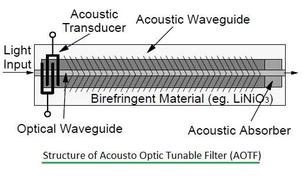Fabry-Perot: Filter, Interferometer, and Cavity Differences
Advertisement
This document clarifies the functional differences between a Fabry-Perot Filter, a Fabry-Perot Interferometer, and a Fabry-Perot Cavity, particularly within the context of fiber optics.
Optical Filters: A General Definition
An optical filter is a device that selectively transmits certain wavelengths of light while blocking others.
Key terms related to optical filters:
- Center Wavelength: The mean wavelength between the two band edges.
- Peak Wavelength: The wavelength at which the filter attenuation is at its lowest point.
- Nominal Wavelength: The wavelength specified by the manufacturer, usually printed on the device. The actual center wavelength might vary slightly.
- Bandwidth: The distance between the filter edges at a specific attenuation level below the peak value.

Fabry-Perot Cavity
The Fabry-Perot cavity refers to the space between the two mirrors in a Fabry-Perot device.
Fabry-Perot Interferometer
An interferometer is any instrument or device that uses interference patterns to make precise measurements of waves.
A Fabry-Perot Interferometer uses an arrangement of parallel mirrors to create interference patterns for optical applications. In this configuration, the mirrors can be moved relative to each other. When the mirrors are fixed in position, it’s often referred to as an Etalon.
Fabry-Perot Filter
A Fabry-Perot Filter is an optical filter consisting of two parallel, partially silvered mirrors.
How it Works
- Light enters the cavity from the outside of one of the mirrors.
- Most of the light is reflected at the first mirror (mirror-1), but some light components enter the cavity.
- When these light components reach the second mirror (mirror-2), some pass through, and most are reflected back into the cavity.
- If the cavity is precisely sized, interference patterns develop. This causes destructive interference for unwanted wavelengths, attenuating them.
- At the same time, a specific wavelength is allowed to pass through due to constructive interference.
Manufacturing Considerations
During the manufacturing process, the following factors are crucial:
- The reflecting surfaces must be extremely flat.
- The mirrors must be perfectly parallel.
- The glass surfaces are silvered to achieve a high reflectivity (e.g., 99%).
Advertisement
 RF
RF

